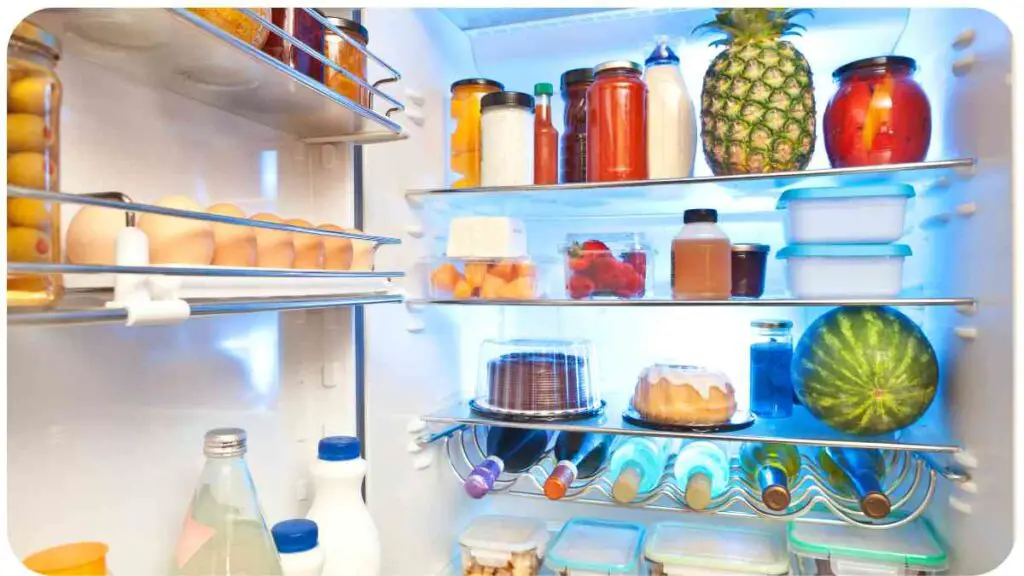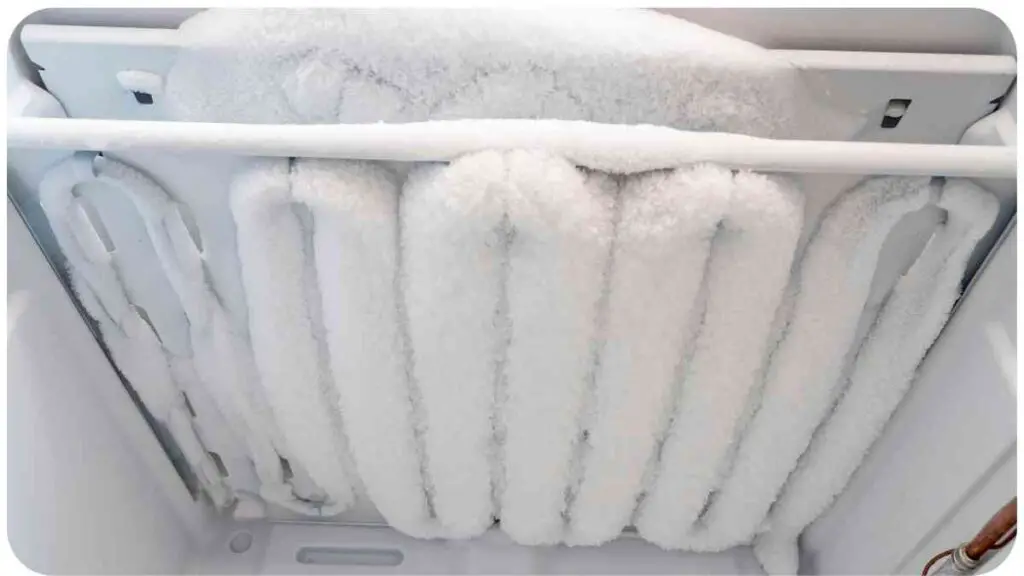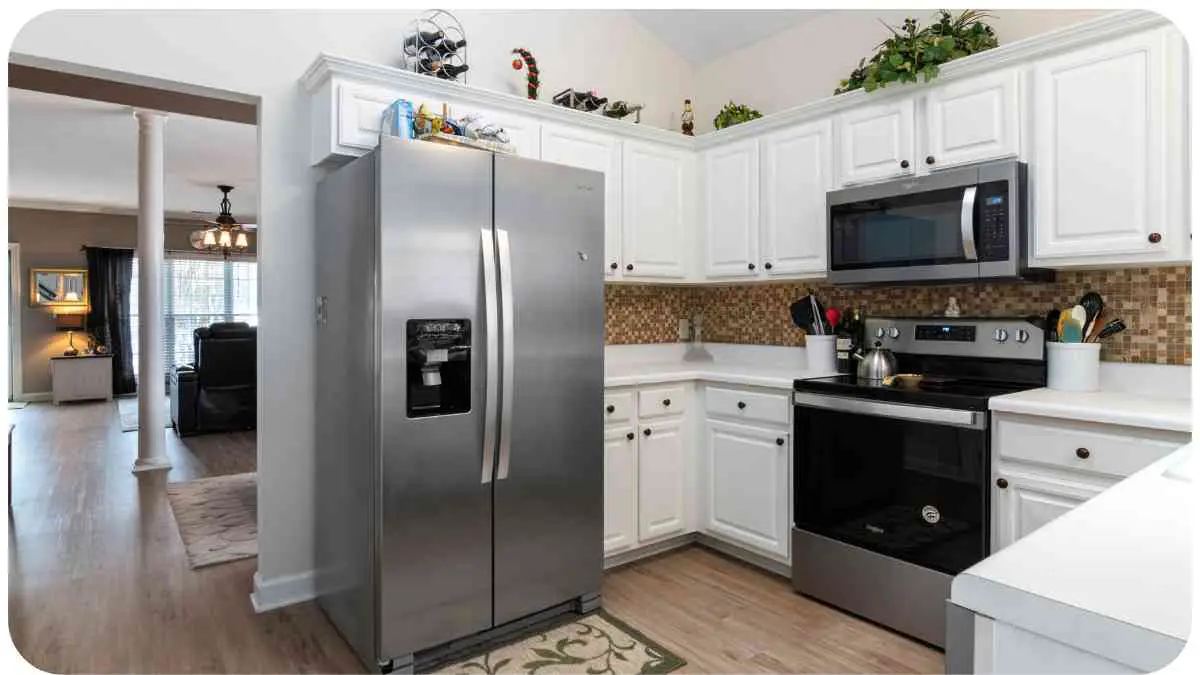Welcome to our comprehensive guide on troubleshooting tips to ensure your refrigerator runs efficiently! A well-functioning refrigerator not only keeps your food fresh but also helps you save on energy costs. In this article, we’ll explore common signs of an inefficient refrigerator and provide practical solutions to enhance its performance.
By following these tips, you can extend the lifespan of your appliance, lower your electricity bills, and contribute to a greener environment. So let’s dive in and discover the secrets to maximize your refrigerator’s efficiency!
| Tips to Keep Your Refrigerator Running Efficiently |
| 1. Proper temperature settings can optimize energy efficiency. |
| 2. Regularly cleaning the condenser coils improves cooling efficiency. |
| 3. Maintaining a well-organized refrigerator ensures better airflow and even cooling. |
| 4. Inspecting and replacing damaged door seals prevents air leaks. |
| 5. Avoid overfilling the refrigerator to allow proper air circulation. |
| 6. Defrosting the freezer regularly enhances energy efficiency. |
| 7. Choosing an energy-efficient refrigerator model can save on energy costs. |
| 8. Performing regular maintenance and repairs increases the lifespan of your appliance. |
| 9. Optimize energy efficiency with LED lighting and adjustable temperature controls. |
| 10. Buying a refrigerator with an Energy Star rating ensures superior energy efficiency. |
Signs of an Inefficient Refrigerator

Before we delve into the troubleshooting tips, let’s familiarize ourselves with some common signs that indicate your refrigerator might be running inefficiently. By recognizing these signs early on, you can take proactive measures to address any issues and optimize its efficiency. Here are a few key indicators:
- Higher Energy Bills: If you notice a sudden increase in your energy bills without any other plausible explanation, your refrigerator may be consuming excessive energy due to inefficiencies.
- Uneven Cooling: When certain areas of your refrigerator are colder or warmer than others, it suggests potential cooling issues that need attention.
- Excessive Condensation: If you frequently find excessive condensation inside your refrigerator or moisture on food stored, it may be a sign of poor temperature and humidity control.
- Noisy Operation: Unusual noises coming from your refrigerator, such as clicking, humming, or grinding sounds, can indicate underlying problems.
- Food Spoilage: Does your food spoil faster than usual, even before its expiration date? Inefficient cooling and temperature fluctuations could be the culprits.
Now that we are aware of some telltale signs, let’s move on to effective troubleshooting tips that can help you address these issues and maximize your refrigerator’s performance.
Upgrade your cooking game with these top kitchen tools. Learn about the best kitchen appliances for healthy cooking to ensure your meals are both efficient and nutritious. Make the most of your fridge’s performance by utilizing the right tools.
Troubleshooting Tips for Optimal Efficiency
Compressor Efficiency
The refrigerator’s compressor is a vital component responsible for cooling the interior. Ensuring its optimal efficiency will go a long way in maintaining the overall performance of the appliance. Regularly clean and vacuum the area around the compressor to remove dust and debris. This prevents heat buildup and allows the compressor to function optimally, lowering energy consumption.
Table: Compressor Maintenance Checklist
| Action | Frequency |
| Clean and vacuum compressor coils | Monthly |
| Check compressor fan ventilation | Quarterly |
| Schedule professional maintenance | Annually |
Condenser Coil Cleaning
The condenser coils are another critical part of the refrigerator’s cooling system. Over time, these coils accumulate dust and grime, hindering the heat exchange process. By periodically cleaning the condenser coils, you can improve energy efficiency and promote proper cooling.
Table: Condenser Coil Cleaning Schedule
| Step | Frequency |
| Unplug the refrigerator | NA |
| Locate the condenser coils | NA |
| Use a brush or vacuum to remove debris | Annually |
| Perform a thorough cleaning | Biennial |
Temperature Settings
The temperature settings of your refrigerator play a crucial role in maintaining optimal food freshness while ensuring energy efficiency. Set the fridge temperature between 37-40°F (2-4°C) and the freezer temperature around 0°F (-18°C) for best results. Avoid setting the temperatures any lower as it may lead to colder than necessary conditions, wasting energy and potentially freezing food items.
Table: Recommended Temperature Settings
| Area | Recommended Temperature |
| Refrigerator | 37-40°F (2-4°C) |
| Freezer | 0°F (-18°C) |
Door Seals and Gaskets
Properly sealed doors are essential to maintain the efficiency of your refrigerator. Over time, door seals and gaskets can wear out, resulting in air leaks and increased energy consumption. Inspect the door seals regularly for any signs of damage or gaps. If you notice any issues, replace them promptly to ensure a tight seal and prevent temperature fluctuations.
Proper storage is key to maintaining the freshness of your produce. Check out our guide on how to store your fruits and veggies: best practices to optimize refrigerator efficiency and extend the lifespan of your fruits and vegetables.
Table: Door Seals and Gaskets Inspection
| Action | Frequency |
| Check for door seal damage | Monthly |
| Clean door seals and gaskets | Quarterly |
| Replace damaged door seals | As needed |
Proper Organization
Efficiently organizing your refrigerator can help optimize its performance. Properly arranging food items ensures better air circulation and prevents obstructions, enabling even cooling. Store perishable items at the appropriate temperature zones, with raw meats on the lower shelves to prevent cross-contamination.
Table: Refrigerator Organization Tips
| Tips | Description |
| Store dairy and eggs on a shelf | Avoid using the refrigerator door for perishable dairy products and eggs. |
| Group similar items together | Keep fruits, vegetables, and condiments in designated sections for easy access. |
| Use transparent containers | Utilize clear storage containers to easily identify food items and minimize search time. |
Regular Defrosting

If you have a freezer that isn’t self-defrosting, it’s crucial to defrost it regularly. Built-up ice and frost diminish the cooling efficiency of the appliance, preventing proper airflow and increasing energy consumption. Plan a regular defrosting schedule to maintain optimum performance and energy efficiency.
Table: Freezer Defrosting Schedule
| Type of Freezer | Defrosting Frequency |
| Self-defrosting | Not applicable |
| Manual defrosting | Every 6 months |
Efficient Use of the Ice Maker
If your refrigerator has an ice maker, it’s essential to use it efficiently to avoid unnecessary energy consumption. Consider the following tips:
- Regularly clean the ice maker: Clean the ice maker and its components according to the manufacturer’s instructions to prevent buildup and ensure proper functioning.
- Adjust ice production: If you find that you don’t use much ice, adjust the ice maker settings to lower ice production. This helps reduce energy usage.
- Avoid overfilling: Do not overfill the ice bin, as it can obstruct proper ice production and cause the ice maker to work harder.
Now that we have discussed some general troubleshooting tips, let’s explore common issues that you may encounter with your refrigerator and their possible solutions.
Understanding your oven’s symbols can enhance your overall kitchen experience. Explore our comprehensive guide to understanding your oven’s symbols and learn how to translate those cryptic icons for efficient meal preparation
Common Issues and Solutions
Leaking Refrigerator
A leaking refrigerator can be a cause for concern. If you notice water pooling around your refrigerator, follow these steps to identify and fix the issue:
- Check water supply line: Inspect the water supply line connected to your refrigerator for any leaks, loose connections, or damage. Replace or repair as necessary.
- Inspect drain pan: The drain pan located at the bottom of the refrigerator may collect excess water. Ensure it is clean and properly positioned to catch any water.
- Clear clogged drain: A clogged drain tube can cause water backup. Use a pipe cleaner or a small brush to clear any blockages.
Table: Leaking Refrigerator Troubleshooting
| Issue | Possible Cause | Solution |
| Leaking water on the floor | Inadequate or damaged water supply line | Check and replace water supply line |
| Water collecting in drain pan | Misaligned or damaged drain pan | Clean and position drain pan properly |
| Clogged water drain | Debris accumulation in the drain tube | Clear the drain tube using a pipe cleaner or a small brush |
Refrigerator Not Cooling
If your refrigerator fails to cool your food properly, it can lead to spoilage. Here are some steps to troubleshoot the issue:
- Check temperature settings: Ensure the temperature settings are set correctly for both the refrigerator and freezer compartments.
- Inspect condenser coils: Dirty condenser coils can hinder cooling performance. Clean them following the manufacturer’s instructions.
- Evaluate door seals: Damaged or worn-out door seals can allow warm air to enter. Replace faulty seals to ensure a tight seal.
- Monitor ventilation: Ensure there is sufficient space around the refrigerator for proper air circulation.
Table: Refrigerator Not Cooling Solutions
| Issue | Possible Cause | Solution |
| Inadequate cooling in the refrigerator | Incorrect temperature settings | Adjust temperature settings according to the manufacturer’s recommendations |
| Poor heat exchange due to dirty condenser coils | Accumulated dust and debris on the condenser coils | Clean condenser coils as per the manufacturer’s guidelines |
| Warm air seeping through damaged door seals | Worn-out or damaged door seals | Replace faulty door seals |
| Lack of proper ventilation around the fridge | Obstructions hindering airflow | Ensure sufficient space for air circulation around the refrigerator |
Excessive Frost Buildup
Excessive frost buildup can impact your refrigerator’s efficiency and hinder proper cooling. Follow these steps to tackle the issue:
- Check door seal: A faulty door seal can cause excess moisture to enter the refrigerator. Inspect and replace damaged seals to maintain proper humidity levels.
- Avoid leaving the door open: Leaving the refrigerator door open for extended periods can lead to increased frost buildup. Ensure the door is closed tightly after use.
- Defrost the freezer: If excessive ice has accumulated in the freezer, perform a manual defrosting to remove built-up frost and restore proper airflow.
Table: Excessive Frost Buildup Solutions
| Issue | Possible Cause | Solution |
| Excessive frost in the freezer | Faulty door seal | Check and replace damaged door seals |
| Frost accumulation due to leaving the door open | Extended periods of door left open | Ensure the door is closed tightly after use |
| Ice buildup impacting airflow and cooling | Inadequate defrosting | Perform a manual defrosting to remove built-up frost |
Strange Noises from the Refrigerator
Unusual noises coming from your refrigerator can be concerning. Here’s what you can do to troubleshoot the issue:
- Check for leveling issues: Ensure the refrigerator is level and stable. Adjust the leveling legs if necessary.
- Clean the condenser fan: Dust and debris can accumulate on the condenser fan, causing it to produce unusual noises. Clean it carefully to eliminate the problem.
- Inspect the fan motor: A malfunctioning fan motor can create strange noises. If identified, replace the motor following the manufacturer’s instructions.
Table: Strange Noises Troubleshooting
| Issue | Possible Cause | Solution |
| Rattling or vibrating noises | Leveling issues | Adjust the leveling legs to ensure the refrigerator is stable |
| Buzzing or humming sounds | Accumulated dust and debris on the condenser fan | Clean the condenser fan as per manufacturer’s guidelines |
| Noises coming from the fan motor | Malfunctioning fan motor | Replace the fan motor following the manufacturer’s instructions |
Food Spoiling Quickly
If you find your food spoiling quickly in the refrigerator, it’s important to address the issue promptly. Consider the following solutions:
- Check temperature settings: Ensure the refrigerator’s temperature is set correctly and adjust if necessary.
- Organize food properly: Store food items in appropriate areas to prevent them from being exposed to inconsistent temperatures or blocked air circulation.
- Inspect door seals: Damaged door seals can allow warm air to seep into the refrigerator, leading to accelerated food spoilage. Replace defective seals.
Table: Food Spoiling Solutions
Don’t fall for nutrition myths! Get the facts straight from our nutrition myths busted: what you need to know article. Learn the truth about food storage and other important aspects to ensure your refrigerator is running optimally.
| Issue | Possible Cause | Solution |
| Rapid food spoilage | Incorrect temperature settings | Adjust temperature settings according to manufacturer’s recommendations |
| Uneven cooling or blocked airflow | Improperly organized food items | Organize food to ensure proper air circulation |
| Warm air entering due to damaged door seals | Worn-out or damaged door seals | Replace faulty door seals |
Choosing an Energy-Efficient Refrigerator
When it comes to maximizing the efficiency of your refrigerator, selecting an energy-efficient model is a smart choice. Here are some key factors to consider when choosing a new refrigerator:
- Energy Star rating: Look for refrigerators with an Energy Star label. This indicates that the appliance meets or exceeds energy efficiency standards set by the Environmental Protection Agency (EPA).
- Size and capacity: Consider purchasing a refrigerator that suits your needs without being excessively large. Larger refrigerators generally consume more energy.
- Features: Energy-saving features such as LED lighting, automatic defrosting, and adjustable temperature controls can help optimize energy efficiency.
- Insulation quality: A well-insulated refrigerator ensures minimal heat transfer, reducing the workload on the cooling system and improving energy efficiency.
- Inverter compressor: Refrigerators with inverter compressors can adjust their speed based on cooling demands, resulting in energy savings.
Before making a final decision, compare the energy consumption and estimated annual operating costs of different models to select the most energy-efficient refrigerator that suits your requirements.
Conclusion
By following these troubleshooting tips and implementing energy-saving practices, you can significantly enhance the efficiency of your refrigerator. Regular maintenance, proper organization, and timely repairs will ensure optimal cooling, extend the lifespan of your appliance, and lower your energy bills.
Remember to periodically check for signs of inefficiency, such as inadequate cooling, frost buildup, or unusual noises, and take appropriate action to address them promptly. Additionally, when it comes time to purchase a new refrigerator, opt for an energy-efficient model to save on energy costs and reduce your environmental footprint. With these tips in mind, you can enjoy a well-performing refrigerator while minimizing energy consumption.
Accidentally burnt your soup? Don’t worry, we’ve got you covered! Check out our easy recovery methods to fix a burnt soup and salvage your dish, minimizing food waste and keeping your kitchen efficient
Further Reading
Here are some additional resources that provide helpful information on keeping your refrigerator running efficiently:
10 Steps to Keep Your Refrigerator Running Efficiently: This blog post provides ten actionable steps to maintain your refrigerator’s efficiency, including proper temperature settings, cleaning techniques, and organizing tips.
5 Tips to Keep Your Refrigerator Running Smoothly: Learn five practical tips to ensure your refrigerator runs smoothly, such as regular maintenance, checking seals, and optimizing temperature settings.
7 Tips for Keeping Your Refrigerator Running Efficiently: This article offers seven valuable tips to maximize the efficiency of your refrigerator, including proper organization, maintenance, and energy-saving features.
FAQs
Here are some frequently asked questions about refrigerator efficiency and their answers:
How often should I clean the condenser coils?
It is recommended to clean the condenser coils at least twice a year to remove accumulated dust and debris, which can hinder cooling efficiency.
Can I adjust the temperature settings to lower than the recommended range for energy savings?
No, it is not advisable to set the temperature lower than the recommended range (37-40°F for the refrigerator and 0°F for the freezer) as it can lead to unnecessary energy consumption without providing significant benefits.
Should I keep my refrigerator fully stocked for better efficiency?
Maintaining a properly stocked refrigerator is beneficial for efficiency. The stored items help retain the cool air inside when the door is open, reducing temperature fluctuations and reducing energy consumption.
Can I store hot food directly in the refrigerator?
No, hot food should be allowed to cool down before placing it in the refrigerator. Putting hot food inside will raise the internal temperature, causing the refrigerator to work harder to cool back down.
How can I test the effectiveness of my refrigerator door seals?
A simple test involves closing the door on a dollar bill and trying to pull it out. If the bill slips out easily, it may indicate a defective seal that needs to be replaced.

Hi, I’m Hellen James! I’m a professional chef who has been cooking for over 12 years. In my career, I’ve worked at some of the world’s most prestigious hotels and restaurants. My expertise lies in creating recipes that are simple but delicious, and I love to experiment with new ingredients and techniques. I started this blog because I want to share my passion for cooking with everyone who loves food as much as I do.


